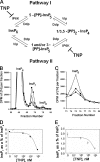Characterization of a selective inhibitor of inositol hexakisphosphate kinases: use in defining biological roles and metabolic relationships of inositol pyrophosphates
- PMID: 19208622
- PMCID: PMC2667744
- DOI: 10.1074/jbc.M900752200
Characterization of a selective inhibitor of inositol hexakisphosphate kinases: use in defining biological roles and metabolic relationships of inositol pyrophosphates
Abstract
Inositol hexakisphosphate kinases (IP6Ks) phosphorylate inositol hexakisphosphate (InsP(6)) to yield 5-diphosphoinositol pentakisphosphate (5-[PP]-InsP(5) or InsP(7)). In this study, we report the characterization of a selective inhibitor, N(2)-(m-(trifluoromethy)lbenzyl) N(6)-(p-nitrobenzyl)purine (TNP), for these enzymes. TNP dose-dependently and selectively inhibited the activity of IP6K in vitro and inhibited InsP(7) and InsP(8) synthesis in vivo without affecting levels of other inositol phosphates. TNP did not inhibit either human or yeast Vip/PPIP5K, a newly described InsP(6)/InsP(7) 1/3-kinase. Overexpression of IP6K1, -2, or -3 in cells rescued TNP inhibition of InsP(7) synthesis. TNP had no effect on the activity of a large number of protein kinases, suggesting that it is selective for IP6Ks. TNP reversibly reduced InsP(7)/InsP(8) levels. TNP in combination with genetic studies was used to implicate the involvement of two pathways for synthesis of InsP(8) in yeast. TNP induced a fragmented vacuole phenotype in yeast, consistent with inhibition of Kcs1, a Saccharomyces cerevisiae IP6K. In addition, it also inhibited insulin release from Min6 cells in a dose-dependent manner further implicating InsP(7) in this process. TNP thus provides a means of selectively and rapidly modulating cellular InsP(7) levels, providing a new and versatile tool to study the biological function and metabolic relationships of inositol pyrophosphates.
Figures










Similar articles
-
Inositol pyrophosphates modulate S phase progression after pheromone-induced arrest in Saccharomyces cerevisiae.J Biol Chem. 2013 Jan 18;288(3):1717-25. doi: 10.1074/jbc.M112.412288. Epub 2012 Nov 24. J Biol Chem. 2013. PMID: 23179856 Free PMC article.
-
Structural analysis and detection of biological inositol pyrophosphates reveal that the family of VIP/diphosphoinositol pentakisphosphate kinases are 1/3-kinases.J Biol Chem. 2009 Jan 16;284(3):1863-72. doi: 10.1074/jbc.M805686200. Epub 2008 Nov 3. J Biol Chem. 2009. PMID: 18981179 Free PMC article.
-
The inositol hexakisphosphate kinase family. Catalytic flexibility and function in yeast vacuole biogenesis.J Biol Chem. 2000 Aug 11;275(32):24686-92. doi: 10.1074/jbc.M002750200. J Biol Chem. 2000. PMID: 10827188
-
Inositol Pyrophosphates as Versatile Metabolic Messengers.Annu Rev Biochem. 2024 Aug;93(1):317-338. doi: 10.1146/annurev-biochem-030222-121901. Annu Rev Biochem. 2024. PMID: 39094034 Review.
-
Targeting the Inositol Pyrophosphate Biosynthetic Enzymes in Metabolic Diseases.Molecules. 2020 Mar 19;25(6):1403. doi: 10.3390/molecules25061403. Molecules. 2020. PMID: 32204420 Free PMC article. Review.
Cited by
-
The regulation of runt-related transcription factor 2 by fibroblast growth factor-2 and connexin43 requires the inositol polyphosphate/protein kinase Cδ cascade.J Bone Miner Res. 2013 Jun;28(6):1468-77. doi: 10.1002/jbmr.1867. J Bone Miner Res. 2013. PMID: 23322705 Free PMC article.
-
Inositol pyrophosphates mediate the effects of aging on bone marrow mesenchymal stem cells by inhibiting Akt signaling.Stem Cell Res Ther. 2014 Mar 26;5(2):33. doi: 10.1186/scrt431. Stem Cell Res Ther. 2014. PMID: 24670364 Free PMC article.
-
The Significance of the Bifunctional Kinase/Phosphatase Activities of Diphosphoinositol Pentakisphosphate Kinases (PPIP5Ks) for Coupling Inositol Pyrophosphate Cell Signaling to Cellular Phosphate Homeostasis.J Biol Chem. 2017 Mar 17;292(11):4544-4555. doi: 10.1074/jbc.M116.765743. Epub 2017 Jan 26. J Biol Chem. 2017. PMID: 28126903 Free PMC article.
-
Understanding inositol pyrophosphate metabolism and function: kinetic characterization of the DIPPs.FEBS Lett. 2013 Nov 1;587(21):3464-70. doi: 10.1016/j.febslet.2013.08.035. Epub 2013 Sep 8. FEBS Lett. 2013. PMID: 24021644 Free PMC article.
-
IP6K structure and the molecular determinants of catalytic specificity in an inositol phosphate kinase family.Nat Commun. 2014 Jun 24;5:4178. doi: 10.1038/ncomms5178. Nat Commun. 2014. PMID: 24956979 Free PMC article.
References
-
- Luo, H. R., Huang, Y. E., Chen, J. C., Saiardi, A., Iijima, M., Ye, K., Huang, Y., Nagata, E., Devreotes, P., and Snyder, S. H. (2003) Cell 114 559-572 - PubMed
-
- Saiardi, A., Caffrey, J. J., Snyder, S. H., and Shears, S. B. (2000) J. Biol. Chem. 275 24686-24692 - PubMed
-
- Saiardi, A., Erdjument-Bromage, H., Snowman, A. M., Tempst, P., and Snyder, S. H. (1999) Curr. Biol. 9 1323-1326 - PubMed
MeSH terms
Substances
Grants and funding
LinkOut - more resources
Full Text Sources
Other Literature Sources
Molecular Biology Databases
Miscellaneous

